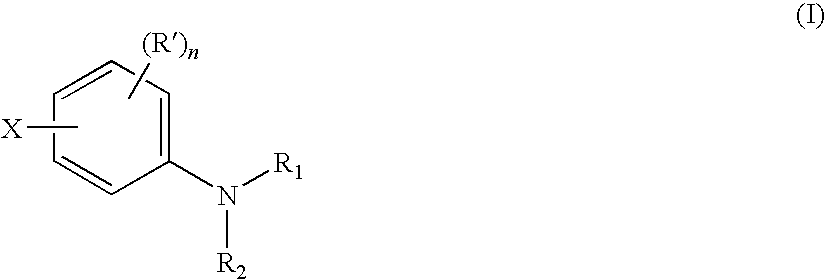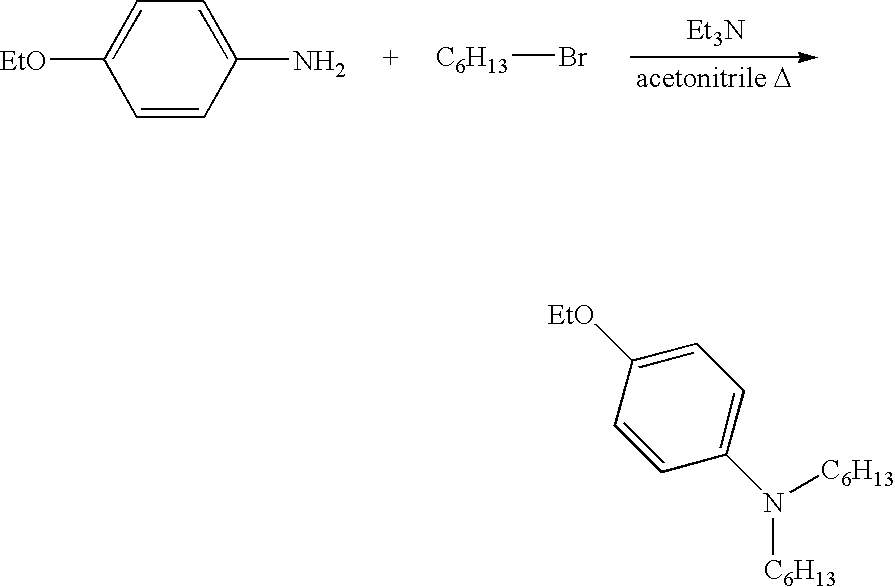Aniline compounds as ashless TBN sources and lubricating oil compositions containing same
a technology of ashless tbn and lubricating oil, which is applied in the direction of foam dispersion/prevention, separation processes, additives, etc., can solve the problems of oxidation catalyst poisoning, less effective, claim that such lubricants will provide sufficient tbn, etc., and achieve the effect of increasing the tbn of lubricating oil compositions
- Summary
- Abstract
- Description
- Claims
- Application Information
AI Technical Summary
Benefits of technology
Problems solved by technology
Method used
Image
Examples
synthesis example 1
[0086]To a solution of 25 g of p-phenetidine (0.18 moles) and 90 g of 1 bromohexane (0.545 moles) in 100 mL of acetonitrile in a 4-neck 250 mL round bottom flask equipped with a mechanical stirrer, condenser / Dean-Stark trap, and inlets for nitrogen, 17.2 mL of triethylamine (0.123 moles) were charged. The reaction mixture was heated to, and maintained at, 100° C. After three (3) days, the reaction was completed, as confirmed by HPLC. The resulting mixture was treated with diluted NaOH aqueous solution and extracted with ethyl acetate. The combined organic layer was washed with water, brine and dried (MgSO4). The solvent was concentrated by rotovap in vacuum to obtain 53 g of product. The structure of the product was confirmed by 1H- and 13C-NMR.
[0087]The reaction scheme for the above-synthesis is shown below:
[0088]
synthesis example 2
[0089]450 g of phenetidine (3.28 moles), 1682 g of 2-ethylhexanal (13.1 moles), 45 g of 10% Pd / C and 2 L of dry methanol were charged into a Parr reactor. The reactor was pressurized to 10 bar with hydrogen and stirred with heating to 100° C. The reaction was monitored by HPLC to completion. The reactor was then cooled to room temperature and the catalyst was removed by filtration. Distillation of the reaction mixture yielded 800 g of product, the structure of which was confirmed by 1H- and 13C-NMR.
[0090]The reaction scheme for the above-synthesis is shown below:
[0091]
TBN Performance
[0092]The basicity of a lubricating oil composition can be determined by acid titration. The resulting neutralization number is expressed as total base number, or TBN, and can be measured using various methods. Two methods conventionally selected to evaluate ashless base sources are ASTM D4739 (potentiometric hydrochloric acid titration) and ASTM D2896 (potentiometric perchloric acid titration). ASTM D28...
example 3
[0093]A fully formulated lubricating oil composition containing dispersant, a detergent mixture, antioxidant, ZDDP antiwear agent, pour point depressant and viscosity modifier, in base oil was prepared. This lubricating oil composition, which was representative of a commercial crankcase lubricant, was used as a reference lubricant. 1.00 mass % and 2.00 mass % of N,N-dihexylaniline, an aniline compound hereinafter referred to as Non-Preferred Inventive Aniline Compound (NPIAC)-1, was added to the reference lubricant. An additional amount of base oil was added to each of the samples to provide comparable total mass. The TBN of each of the resulting samples was determined in accordance with each of ASTM D4739 and ASTM D2896 (in units of mg KOH / g). The results are shown in Table III:
[0094]
TABLE IIIExampleComparativeComparativeReferenceSample 1Sample 2Reference Sample (g)95.0095.0095.00Added Base Oil (g)5.004.003.00NPIAC-1 (g)—1.002.00Total Weight (g)100.00100.00100.00TBN by D47398.758.8...
PUM
| Property | Measurement | Unit |
|---|---|---|
| mass % | aaaaa | aaaaa |
| mass % | aaaaa | aaaaa |
| mass % | aaaaa | aaaaa |
Abstract
Description
Claims
Application Information
 Login to View More
Login to View More - R&D
- Intellectual Property
- Life Sciences
- Materials
- Tech Scout
- Unparalleled Data Quality
- Higher Quality Content
- 60% Fewer Hallucinations
Browse by: Latest US Patents, China's latest patents, Technical Efficacy Thesaurus, Application Domain, Technology Topic, Popular Technical Reports.
© 2025 PatSnap. All rights reserved.Legal|Privacy policy|Modern Slavery Act Transparency Statement|Sitemap|About US| Contact US: help@patsnap.com



